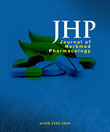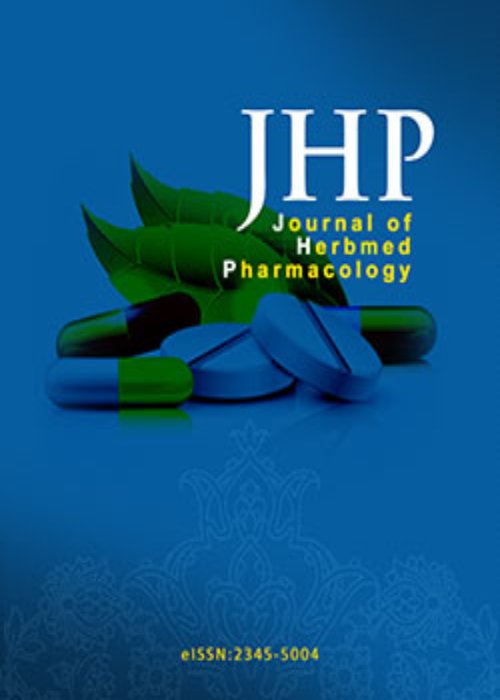فهرست مطالب

Journal of Herbmed Pharmacology
Volume:6 Issue: 2, Apr 2017
- تاریخ انتشار: 1396/02/19
- تعداد عناوین: 8
-
-
Pages 49-54IntroductionEleucine indica is a medicinal plant used by the Ibibios of Nigeria in the treatment of malaria but its safety with chronic use has not been determined. This study was to evaluate the toxicological effects of the extract in adult albino Wistar rats.MethodsThe rats of both sexes were randomized into 5 groups of 6 animals per group and orally administered with extract (200, 400 and 600 mg/kg) for groups 24, respectively. Group 1 received distilled water (10 mL/kg) orally and served as negative control while group 5 was administered with 100 mg/kg of silymarin orally. Drugs were administered on alternate days for 28 days at 09.00 am. Toxic manifestations and mortality were monitored daily and weight changes of animals were recorded every week. On day 29, after an overnight fast, the animals were weighed, anaesthetized with light chloroform. An autopsy was performed during which any macroscopic abnormalities were noted. The brain, heart, liver, spleen, kidney and lungs were weighed immediately after removal. Samples of these organs were fixed in 10% formalin and kept in that solution for further histopathological examination. Data were analysed using one-way analysis of variance (ANOVA) followed by Tukey Kramer multiple comparison post-test.ResultsThe results showed that organ weights were not affected but animal weights increased significantly (PConclusionBased on these results, the plant has a potential to damage the lungs when used on the long term. Its use as herbal remedy should be for short periods at a time.Keywords: Eleucine indica, Histopathologic, Ethanolic, Whole-plant, Assessment, Wistar rats
-
Pages 55-61IntroductionXimenia americana is a highly branched shrub mainly found in tropics of Asia, Africa, New Zealand, Central and South America among others. In most parts of Africa, X. americana is used in folklore to treat various disorders such as oedema, pain, fever, helminthiasis, diarrhea and burns among others. There is no published data on anti-inflammatory activities of organic extracts of X. americana. It is against this background that this research was carried out. The study tested for the anti-inflammatory activities of dichloromethane-methanolic (DCMMeOH) leaf and stem bark extracts of X. americana in rats.MethodsThe plant materials were collected from Mbeere North sub-county, Embu county, Kenya. Methanol and dichloromethane in the ratio of 1:1 was used to extract the active compounds. Five to 6 weeks old Swiss Albino mice were employed for the anti-inflammatory studies. Animals were divided into 6 groups of 5 mice each: normal, negative, reference and three experimental groups (50, 100 and 150 mg/kg body weight). Inflammation was induced experimentally using carrageenan. The experimental groups were treated with predetermined dose quantities of prepared extracts. Diclofenac was used as the reference drug. Data was analyzed using one-way analysis of variance (ANOVA).ResultsThe extracts from the leaves reduced hind paw circumference by between 0.91% and 16.90% while the stem bark extracts reduced hind paw circumference by between 5.84% and 29.00%. Diclofenac reduced right hind paw circumference by 1.32%-29.60%. Qualitative phytochemical screening showed presence of alkaloids, flavonoids, steroids, saponins, cardiac glycosides, phenolics and terpenoids in the extract.ConclusionThe study established that the DCM-MeOH leaf and stem bark extracts of X. americana is effective in management of inflammation and therefore it can be explored as a possible bio-resource in the development of herbal medicines.Keywords: Ximenia americana, DCM-MeOH, Anti-inflammation, Hind paw, Diclofenac, Carrageenan
-
Pages 62-68IntroductionCandidiasis-associated biofilm formed by Candida species complicates treatment and contributes to unacceptable high mortality rates. We performed the aqueous and ethanol extracts of the different parts of Malva sylvestris, Dorema aucheri, Ferulago angulata and Citrullus colocynthis plants to identify best plant extract that inhibits growth of Candida albicans or Candida krusei, and conducted a series of follow-up studies to examine the inhibitors of C. albicans biofilm formation of the identified plant extract.MethodsThe antifungal activities of the aqueous and ethanol extracts of the different parts of M. sylvestris, D. aucheri, F. angulata and C. colocynthis plants were evaluated in vitro using disk diffusion test and broth microdilution test against C. albicans and C. krusei. The crystal violet assay, morphological response and expression pattern of hyphal wall protein 1 (HWP1) gene were carried out to investigate the biofilm-inhibitory properties of the best plant extract tested in C. albicans.ResultsThe screen identified ethanol extract of M. sylvestris root that largely represented antifungal activity among the tested extracts. M. sylvestris root inhibited C. albicans biofilm formation. Ethanol extract of M. sylvestris root demonstrated significant reduction in C. albicans biofilm formation (PConclusionThese results provide proof of concept for the implementation of ethanol extract of M. sylvestris root as inhibitor of C. albicans biofilm formation.Keywords: Biofilm_Candida albicans_Candida krusei_Hyphal wall protein 1 (HWP1)
-
Pages 69-73IntroductionPrevious studies revealed that anise (Pimpinella anisum L.) has several pharmacological effects including analgesic, antidepressant, anxiolytic, anti-inflammatory and antispasmodic activities. This study aimed to evaluate its effect on morphine physical dependence in mice.MethodsIn this experimental study, 40 male NMRI mice (25-30 g) were randomly divided into 5 groups of 8. Control group received morphine and normal saline (10 mL/kg, i.p.) and other groups received diazepam (5 mg/kg) plus one of three doses of P. anisum (50,100 or 200 mg/kg, i.p.). Dependence was induced by administration of increasing doses (50-75 mg/kg, i.p.) of morphine. A time of 30 minutes after naloxone injection was considered for the critical period of the withdrawal syndrome. The number of jumps and scores of 0 to 3 were given for incidences of wet dog shakes, teeth chattering, climbing, writing, diarrhea, grooming, and rearing during a 30-minute period.ResultsAll doses of P. anisum (P 0.05). Climbing, rearing and wet dog shakes reduced only by the high dose of the extract (PConclusionThese results obviously show that P. anisum ethanolic extract is effective in suppression of morphine physical dependence and further studies are needed to find out the responsible constituents and also the exact mechanisms of actions.Keywords: Pimpinella anisum L., Addiction, Morphine, Physical dependence, Mice
-
Pages 74-79IntroductionDue to antimicrobial and dental plaque control activities, herbal mouthwashes lead to an improvement in oral health. Although chemical mouthwashes have demonstrated the greatest antimicrobial and anti-inflammatory effects, their usage has been limited because of their numerous side effects. The aim of this study was to assess the antifungal activity of herbal mixtures containing Nigella sativa, Foeniculum vulgare and Camellia sinensis against oral isolates of Candida from denture wearers.MethodsWe selected 93 individuals wearing complete denture prosthesis. Samples were collected from oral mucosa and dentures and cultured onto Sabouraud dextrose agar (SDA). The antifungal activities of N. sativa, F. vulgare and C. sinensis and their mixtures (no. 1, 2 and 3) against oral isolates of Candida were determined using punch-hole test.ResultsThe oral cavities of all denture wearers were colonized with yeasts. Among the Candida species, Candida albicans was the most frequently recovered species (45; 48.4%), followed by C. tropicalis (14; 15%), C. krusei (9; 9.7%), C. glabrata (6; 6.5%), C. dubliniensis (4; 4.3%) and Candida spp. (15; 16.1%). Among the tested plants, N. sativa (mean value: 12.3 mm) and F. vulgare (mean value: 7.9 mm) showed positive results against all Candida isolates. The results exhibited that all herbal mixtures were active against various tested Candida isolates, ranging from 7.8 to 15 mm, 7.6 to 15.5 mm and 7 to 15 mm inhibition zones for herbal mixtures no. 1, 2 and 3, respectively.ConclusionThe results indicated that C. albicans was the most prevalent Candida species. N. sativa and F. vulgare were good antifungal agents against oral species of Candida isolated from individuals wearing complete dentures, hence, there is a possible usefulness as therapeutic agents.Keywords: Denture wearer, Oral microflora, Candida albicans, Herbal mixture, Nigella sativa
-
Pages 80-84IntroductionThe aim of this study was to investigate the effects of 12-week aerobic exercise and lavender essence on cognitive states and brain-derived neurotrophic factor (BDNF) levels of elderly with mild cognitive impairment (MCI).MethodsIn this clinical study, 40 elderly whose scores for minimental state examination (MMSE) ranged 21 to 25 were purposively selected by simple sampling. They were randomly divided into 4 equal groups: aerobic exercise, lavender extract, aerobic-lavender. and placebo. They underwent their respective treatments for 12 weeks. The aerobic exercise consisted of 8-minute running session with intensity of 75%-85% HRR Max for the first session. One minute was added to the running span after each 2 sessions. Accordingly, the running span reached 26 minutes at the end of the 12-week exercise period. To conduct treatment with lavender, 2 drops of lavender essence were administered twice a day. Before and after the treatments, cognitive state was measured and blood samples collected to measure BDNF.ResultsBDNF levels of the exercise and exercise lavender groups increased significantly compared to those of the other 2 groups (PConclusionCombination of 12-week aerobic exercise and lavender may decelerate or probably halt the progressive process of the impairment via improving the cognitive state in elderly with MCI.Keywords: Aerobic exercise, Lavender, Cognitive state, Brain-derived neurotrophic factor, Cognitive impairment, Elderly
-
Pages 85-89IntroductionIschemia-associated depression and anxiety may occur due to brain damage caused by oxidative stress. A number of reports indicated that treatment with herbal plant extracts with antioxidant properties could lead to a significant reduction in Ischemic complications. The aim of this study was to evaluate the behaviors of ischemic rats through animal models of anxiety and exploratory behavior (open field) to determine the efficiency of pomegranate seed extract (PGSE) as antioxidant.MethodsIn this study, 21 male Wistar rats (250 ± 20 g) were randomly divided into 3 groups with 7 in each: 1) Control; 2) Ischemic; 3) Ischemic plus PGSE (14 days). In order to create ischemia/hypoperfusion, carotid arteries were ligatured and cut bilaterally. Then, plus maze and open-field tests were used for the measurement.ResultsIschemic rats showed a significant increase in anxiety or decrease approach and reduction locomotor activity compared to control group. Fourteen days administration of PGSE significantly improved the immobilization and ischemia-induced anxiety.ConclusionPGSE exhibits therapeutic potential for anxiety and depression, which is most likely related, at least in part, to its antioxidant and free radical scavenging actions.Keywords: Ischemia, Anxiety, Pomegranate seed extract, Rats
-
Pages 90-93IntroductionMedicinal plants are considered to be safer, non-toxic and less harmful as compared to synthetic based drugs that are available. In this study, we focused on aqueous leaves extract of Calotropis gigantea for determining its antimicrobial activity in infected (dengue) human whole blood samples using flow cytometry.MethodsInfected dengue human blood samples (n = 5; confirmed on the basis of NS1 antigen to dengue virus;) were collected from pathology lab and evaluated its blood counts (lymphocytes, monocytes and granulocytes count); forward scatter (FSC) and side scatter (SSC) including CD14 monocyte surface marker following the use of variable doses of aqueous leaves extract of C. gigantea.ResultsIn this study, the results showed that aqueous leaves extract of C. gigantea caused enhancement in case of granulocytes FSC (shape and size) and SSC (granularity) counts but this aqueous extract inhibited CD14 monocyte surface marker population at higher doses. In contrast, dengue infected human blood samples used as control showed sudden decline in granulocytes count but there was enhancement in CD14 monocyte surface marker as compared to control group.ConclusionOverall, C. gigantea in the form of aqueous leaves extract showed anti-dengue activity in infected human whole blood samples.Keywords: Calotropis gigantea, Antimicrobial, Dengue, Granulocytes, Aqueous extract


